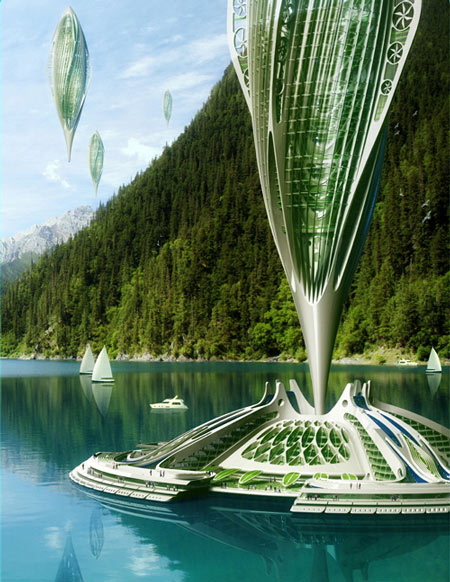Following the "tread lightly on the earth" theme, not treading at all is actually an option. The AerosCraft lighter than air vehicle that is an innovation on the blimp theme is close to flying their first prototype (video).
Extrapolating that technology combined with solar and wind generation of electricity, one might envision a "sky yacht" living space. For our purposes, a living space in the sky takes the phrase "minimum impact on the planet" literally. The first prototype is a $50 million dollar endeavor. But some day in the future, they may be as common as buying a house. Let's say two generations away.
 Combine this idea with "dense plasma fusion" reactor generators (not yet proven, links here), which produce helium as a byproduct of producing electricity, one could foresee entire cities in the sky "star wars style".
Combine this idea with "dense plasma fusion" reactor generators (not yet proven, links here), which produce helium as a byproduct of producing electricity, one could foresee entire cities in the sky "star wars style".These platforms would require terrestrial resources and facilities to build, but other aspects of living "untethered" from the ground have some energy and environment saving advantages.
The ability to move the vehicle to locations where the weather is most pleasant means that heating and cooling costs would be practically eliminated (mere altitude change would suffice). Picture a nomadic style of floating north in the summer, south in the winter like snow birds. Becoming migratory, nomads. Scenario 3.
Hotel design.
This is a drastic change from living in one place on the ground, I realize. But for the moment, let's just explore the idea in light of sailors on the ocean.
http://www.ecofriend.com/eco-transportation-aeolus-airship-aerodynamic-helium-powered-air-vehicle.html
http://photochloride4.rssing.com/browser.php?indx=3786738&item=275
All those facilities would resemble those of a ship, or yacht, or sailboat. Live aboard ref.
Some specs for a live aboard design:
- 10,000 watts of photovoltaic panels
- 20,000 watts of battery storage
- 1500 watts of wind turbines (3 small turbines)
- Electric outboard drives
- Outboard drives can rotate 180 degrees as well as instant reverse
- Composting toilets
- Solar hot water and cabin heating
- Roof collects water
- Solar distillation for potable water
- 5 camera video
- GPS feedback system for maintaining station without anchor
How would such a vessel contend with storms?
Regular landings to re-supply (provision) are necessary. How is that done? Is it economical to land the entire vessel frequently? Is there a transfer vessel / elevator to access the platform without landing? Is that necessary? Is staying aloft doable or is flying only useful for moving from one location to another? What's the safest state, landed on the ground, floating untethered, floating at anchor, landed on water? Obviously it's landed and stored in a hanger, but this scenario assumes something larger than most hangars, and I would like to see something permanently aloft.
A standard guideline of flying at 10k feet elevation would avoid most obstacles, but not all, mountains would still be a hazard. More than 10k feet the hazard is altitude sickness. 8k feet is actually better from that respect.
===========================
video sequence
wilderness
closer look shows patterns in the bush
follow an old and overgrown road towards a green mountain
green mountain is a city shrouded in trees
waterfalls and green mixed with people standing, talking, on phones,
walking on elevated walkways, animals on the ground underneath
a blimp sits in the water
another lifts off to join more in the sky
among the clouds, many blimps are linked by walkways in a mass collection
people shuttle back and forth from the ground to the sky in smaller blimp vehicles.
===========================
just a mention of another favorite flyer of mine. New flying designs are fraught with hurdles and setbacks... http://www.wingco.com/progress.htm
more later







No comments:
Post a Comment